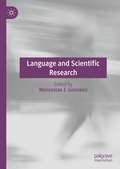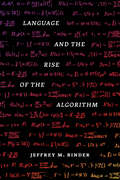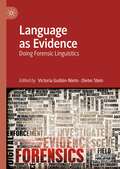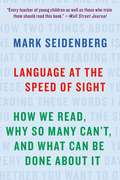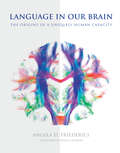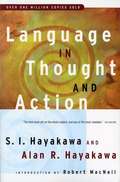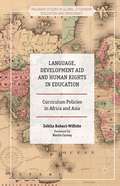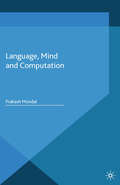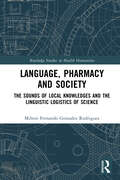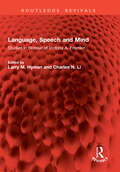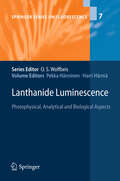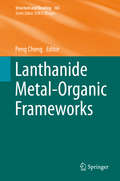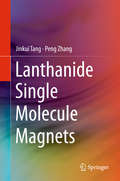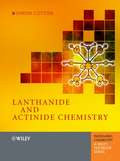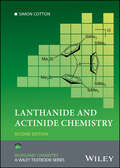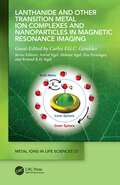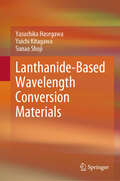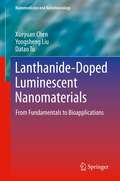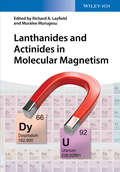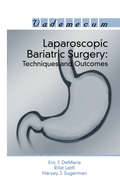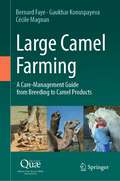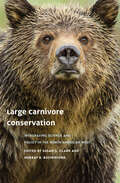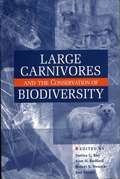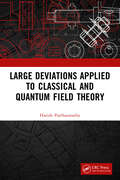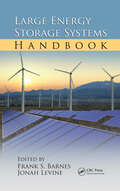- Table View
- List View
Language and Scientific Research
by Wenceslao J. GonzalezThis book analyzes the role of language in scientific research and develops the semantics of science from different angles. The philosophical investigation of the volume is divided into four parts, which covers both basic science and applied science: I) The Problem of Reference and Potentialities of the Language in Science; II) Language and Change in Scientific Research: Evolution and Historicity; III) Scientific Language in the Context of Truth and Fiction; and IV) Language in Mathematics and in Empirical Sciences. Language plays a key role in science: our access to the theoretical, practical or evaluative dimensions of scientific activity begins with the mastery of language, continues with a deepening in the use of language and reaches the level of contribution when it creates new terms or changes them in sense and reference. This reveals the compatibility between objectivity in semantic contents and historicity in the progress of science. This volume is a valuable enrichment to students, academics and other professionals interested in science in all its forms, who seek to deepen the role that language plays in its structure and dynamics.
Language and the Rise of the Algorithm
by Jeffrey M. BinderA wide-ranging history of the algorithm. Bringing together the histories of mathematics, computer science, and linguistic thought, Language and the Rise of the Algorithm reveals how recent developments in artificial intelligence are reopening an issue that troubled mathematicians well before the computer age: How do you draw the line between computational rules and the complexities of making systems comprehensible to people? By attending to this question, we come to see that the modern idea of the algorithm is implicated in a long history of attempts to maintain a disciplinary boundary separating technical knowledge from the languages people speak day to day. Here Jeffrey M. Binder offers a compelling tour of four visions of universal computation that addressed this issue in very different ways: G. W. Leibniz’s calculus ratiocinator; a universal algebra scheme Nicolas de Condorcet designed during the French Revolution; George Boole’s nineteenth-century logic system; and the early programming language ALGOL, short for algorithmic language. These episodes show that symbolic computation has repeatedly become entangled in debates about the nature of communication. Machine learning, in its increasing dependence on words, erodes the line between technical and everyday language, revealing the urgent stakes underlying this boundary. The idea of the algorithm is a levee holding back the social complexity of language, and it is about to break. This book is about the flood that inspired its construction.
Language as Evidence: Doing Forensic Linguistics
by Dieter Stein Victoria Guillén-NietoThis edited book provides a comprehensive survey of the modern state of the art in forensic linguistics. Part I of the book focuses on the role of the linguist as an expert witness in common law and civil law jurisdictions, the relation of expert witnesses and lawyers, ethics standards, and courtroom interaction. Part II deals with some of the major areas of expertise of forensic linguistics as the scientific study of language as evidence, namely authorship identification, speaker identification, text authentication, deception and lie detection, plagiarism detection, and cyber language crimes. This book is intended to be used as a reference for academics, students and practitioners of Linguistics, Forensic Linguistics, Law, Criminology, and Forensic Psychology, among other disciplines.
Language at the Speed of Sight: How We Read, Why So Many Can't, And What Can Be Done About It
by Mark SeidenbergAccording to a leading cognitive scientist, we've been teaching reading wrong. The latest science reveals how we can do it right. <p><p>In 2011, when an international survey reported that students in Shanghai dramatically outperformed American students in reading, math, and science, President Obama declared it a "Sputnik moment": a wake-up call about the dismal state of American education. Little has changed, however, since then: over half of our children still read at a basic level and few become highly proficient. <p><p> Many American children and adults are not functionally literate, with serious consequences. Poor readers are more likely to drop out of the educational system and as adults are unable to fully participate in the workforce, adequately manage their own health care, or advance their children's education. <p><p>In Language at the Speed of Sight, internationally renowned cognitive scientist Mark Seidenberg reveals the underexplored science of reading, which spans cognitive science, neurobiology, and linguistics. As Seidenberg shows, the disconnect between science and education is a major factor in America's chronic underachievement. <p><p>How we teach reading places many children at risk of failure, discriminates against poorer kids, and discourages even those who could have become more successful readers. Children aren't taught basic print skills because educators cling to the disproved theory that good readers guess the words in texts, a strategy that encourages skimming instead of close reading. <p><p>Interventions for children with reading disabilities are delayed because parents are mistakenly told their kids will catch up if they work harder. Learning to read is more difficult for children who speak a minority dialect in the home, but that is not reflected in classroom practices. By building on science's insights, we can improve how our children read, and take real steps toward solving the inequality that illiteracy breeds. <p><p>Both an expert look at our relationship with the written word and a rousing call to action, Language at the Speed of Sight is essential for parents, educators, policy makers, and all others who want to understand why so many fail to read, and how to change that.
Language in Our Brain: The Origins of a Uniquely Human Capacity (The\mit Press Ser.)
by Angela D. FriedericiA comprehensive account of the neurobiological basis of language, arguing that species-specific brain differences may be at the root of the human capacity for language.Language makes us human. It is an intrinsic part of us, although we seldom think about it. Language is also an extremely complex entity with subcomponents responsible for its phonological, syntactic, and semantic aspects. In this landmark work, Angela Friederici offers a comprehensive account of these subcomponents and how they are integrated. Tracing the neurobiological basis of language across brain regions in humans and other primate species, she argues that species-specific brain differences may be at the root of the human capacity for language.Friederici shows which brain regions support the different language processes and, more important, how these brain regions are connected structurally and functionally to make language processes that take place in milliseconds possible. She finds that one particular brain structure (a white matter dorsal tract), connecting syntax-relevant brain regions, is present only in the mature human brain and only weakly present in other primate brains. Is this the “missing link” that explains humans' capacity for language?Friederici describes the basic language functions and their brain basis; the language networks connecting different language-related brain regions; the brain basis of language acquisition during early childhood and when learning a second language, proposing a neurocognitive model of the ontogeny of language; and the evolution of language and underlying neural constraints. She finds that it is the information exchange between the relevant brain regions, supported by the white matter tract, that is the crucial factor in both language development and evolution.
Language in Thought and Action
by Alan R. Hayakawa S. I. HayakawaA revised, updated edition of S. I. Hayakawa's classic work on semantics. He discusses the role of language, its many functions, and how language shapes our thinking. Introduction by Robert MacNeil; Index.
Language, Development Aid and Human Rights in Education: Curriculum Policies In Africa And Asia (Palgrave Studies In Global Citizenship Education And Democracy Ser.)
by Zehlia Babaci-WilhiteThe debate about languages of instruction in Africa and Asia involves an analysis of both the historical thrust of national government and also development aid policies. Using case studies from Tanzania, Nigeria, South Africa, Rwanda, India, Bangladesh and Malaysia, Zehlia Babaci-Wilhite argues that the colonial legacy is perpetuated when global languages are promoted in education. The use of local languages in instruction not only offers an effective means to contextualize the curriculum and improve student comprehension, but also to achieve quality education and rights in education.
Language, Mind and Computation
by Prakash MondalThis book explores how and in what ways the relationship between language, mind and computation can be conceived of, given that a number of foundational assumptions about this relationship remain unacknowledged in mainstream linguistic theory, yet continue to be the basis of theoretical developments and empirical advances.
Language, Pharmacy and Society: The Sounds of Local Knowledges and the Linguistic Logistics of Science (Routledge Studies in Health Humanities)
by Milton Fernando RodriguezThis book explores the vital role language plays in shaping how we understand and discuss medicines, making for a more detailed study of pharmaceutical and pharmacological language to more clearly understand the intersection of language, health, and culture.Gonzalez Rodriguez charts the development of the language of pharmacy from the mid-19th century onward, drawing on data from Icelandic and Spanish natural language corpora, historical sources, and contemporary data. The book brings together scholarship from sociolinguistics, media, and cultural studies, and the history of science to highlight the possibilities afforded by an interdisciplinary approach to pharmacy-related language.The book will benefit readers by providing a deeper understanding of the intersection between language, science, and culture, making it especially valuable for students and scholars in sociolinguistics, history of science, medical humanities, and cultural studies.
Language, Speech and Mind: Studies in Honour of Victoria A. Fromkin (Routledge Revivals)
by Charles N. Li Larry M. HymanFirst published in 1988, Language, Speech and Mind consists of 18 specially invited contributions to mark Professor Fromkin’s 65th birthday in 1988. It reflects her very special interdisciplinary interests and flair, thereby celebrating her own important contributions in the areas of phonetics, phonology, neurolinguistics, psycholinguistics, and the philosophy of science.
Lanthanide Luminescence
by Pekka Hänninen Harri HärmäLanthanides have fascinated scientists for more than two centuries now, and since efficient separation techniques were established roughly 50 years ago, they have increasingly found their way into industrial exploitation and our everyday lives. Numerous applications are based on their unique luminescent properties, which are highlighted in this volume. It presents established knowledge about the photophysical basics, relevant lanthanide probes or materials, and describes instrumentation-related aspects including chemical and physical sensors. The uses of lanthanides in bioanalysis and medicine are outlined, such as assays for in vitro diagnostics and research. All chapters were compiled by renowned scientists with a broad audience in mind, providing both beginners in the field and advanced researchers with comprehensive information on on the given subject.
Lanthanide Metal-Organic Frameworks
by Peng ChengThe series Structure and Bonding publishes critical reviews on topics of research concerned with chemical structure and bonding. The scope of the series spans the entire Periodic Table and addresses structure and bonding issues associated with all of the elements. It also focuses attention on new and developing areas of modern structural and theoretical chemistry such as nanostructures, molecular electronics, designed molecular solids, surfaces, metal clusters and supramolecular structures. Physical and spectroscopic techniques used to determine, examine and model structures fall within the purview of Structure and Bonding to the extent that the focus is on the scientific results obtained and not on specialist information concerning the techniques themselves. Issues associated with the development of bonding models and generalizations that illuminate the reactivity pathways and rates of chemical processes are also relevant. The individual volumes in the series are thematic. The goal of each volume is to give the reader, whether at a university or in industry, a comprehensive overview of an area where new insights are emerging that are of interest to a larger scientific audience. Thus each review within the volume critically surveys one aspect of that topic and places it within the context of the volume as a whole. The most significant developments of the last 5 to 10 years should be presented using selected examples to illustrate the principles discussed. A description of the physical basis of the experimental techniques that have been used to provide the primary data may also be appropriate, if it has not been covered in detail elsewhere. The coverage need not be exhaustive in data, but should rather be conceptual, concentrating on the new principles being developed that will allow the reader, who is not a specialist in the area covered, to understand the data presented. Discussion of possible future research directions in the area is welcomed. Review articles for the individual volumes are invited by the volume editors. Readership: research scientists at universities or in industry, graduate students.
Lanthanide Single Molecule Magnets
by Peng Zhang Jinkui TangThis book begins by providing basic information on single-molecule magnets (SMMs), covering the magnetism of lanthanide, the characterization and relaxation dynamics of SMMs and advanced means of studying lanthanide SMMs. It then systematically introduces lanthanide SMMs ranging from mononuclear and dinuclear to polynuclear complexes, classifying them and highlighting those SMMs with high barrier and blocking temperatures - an approach that provides some very valuable indicators for the structural features needed to optimize the contribution of an Ising type spin to a molecular magnet. The final chapter presents some of the newest developments in the lanthanide SMM field, such as the design of multifunctional and stimuli-responsive magnetic materials as well as the anchoring and organization of the SMMs on surfaces. In addition, the crystal structure and magnetic data are clearly presented with a wealth of illustrations in each chapter, helping newcomers and experts alike to better grasp ongoing trends and explore new directions. Jinkui Tang is a professor at Changchun Institute of Applied Chemistry, Chinese Academy of Sciences. Peng Zhang is currently pursuing his PhD at Changchun Institute of Applied Chemistry, Chinese Academy of Sciences, with a specific focus on the molecular magnetism of lanthanide compounds under the supervision of Prof. Jinkui Tang.
Lanthanide and Actinide Chemistry
by Simon CottonThe only introduction into the exciting chemistry of Lanthanides and Actinides. The book is based on a number of courses on "f elements" The author has a long experience in teaching this field of chemistry Lanthanides have become very common elements in research and technology applications; this book offers the basic knowledge The book offers insights into a vast range of applications, from lasers to synthesis The Inorganic Chemistry: A Textbook series reflects the pivotal role of modern inorganic and physical chemistry in a whole range of emerging areas, such as materials chemistry, green chemistry and bioinorganic chemistry, as well as providing a solid grounding in established areas such as solid state chemistry, coordination chemistry, main group chemistry and physical inorganic chemistry. Lanthanide and Actinide Chemistry is a one-volume account of the Lanthanides (including scandium and yttrium), the Actinides and the Transactinide elements, intended as an introductory treatment for undergraduate and postgraduate students. The principal features of these elements are set out in detail, enabling clear comparison and contrast with the Transition Elements and Main Group metals. The book covers the extraction of the elements from their ores and their purification, as well as the synthesis of the man-made elements; the properties of the elements and principal binary compounds; detailed accounts of their coordination chemistry and organometallic chemistry, from both preparative and structural viewpoints, with a clear explanation of the factors responsible for the adoption of particular coordination numbers; spectroscopy and magnetism, especially for the lanthanides, with case studies and accounts of applications in areas like magnetic resonance imaging, lasers and luminescence; nuclear separations and problems in waste disposal for the radioactive elements, particularly in the context of plutonium. Latest developments are covered in areas like the synthesis of the latest man-made elements, whilst there is a whole chapter on the application of lanthanide compounds in synthetic organic chemistry. End-of-chapter questions suitable for tutorial discussions are provided, whilst there is a very comprehensive bibliography providing ready access to further reading on all topics.
Lanthanide and Actinide Chemistry (Inorganic Chemistry: A Textbook Series)
by Simon CottonLANTHANIDE AND ACTINIDE CHEMISTRY Lanthanides and actinides, also known as “f elements,” are a group of metals which share certain important properties and aspects of electronic structure. They have a huge range of applications in the production of electronic devices, magnets, superconductors, fuel cells, sensors, and more. The cursory treatment of these important metals in most inorganic chemistry textbooks makes a book-length treatment essential. Since 2006, Lanthanide and Actinide Chemistry has met this need with a thorough, accessible overview. With in-depth accounts of the lanthanides, actinides, and transactinides, this book is ideal for both undergraduate and postgraduate students in inorganic chemistry or chemical engineering courses. Now updated to reflect groundbreaking recent research, this promises to continue as the essential introductory volume on the subject. Readers of the second edition of Lanthanide and Actinide Chemistry will also find: New and expanded subject areas including lanthanide enzymes, single-molecule magnets, luminescence and upconversion, organometallic and coordination chemistry; and many more. Up-to-date information on the myriad modern applications of f-elements Lists of objectives and learning goals at the start of each chapter Lanthanide and Actinide Chemistry is ideal for advanced undergraduates and graduate students in f-element chemistry, inorganic chemistry, or any related field. INORGANIC CHEMISTRY ADVANCED TEXTBOOK This series reflects the pivotal role of modern inorganic and physical chemistry in a whole range of emerging areas, such as materials chemistry, green chemistry and bioinorganic chemistry, as well as providing a solid grounding in established areas such as solid state chemistry, coordination chemistry, main group chemistry and physical inorganic chemistry.
Lanthanide and Other Transition Metal Ion Complexes and Nanoparticles in Magnetic Resonance Imaging (ISSN)
by Geraldes, Carlos F. G. C.Since the development of the first clinical MRI contrast agent, Gd(DTPA) (or Magnevist®) in the early 1980s, another three linear and three macrocyclic (eg. Gd(DOTA) (Dotarem®) have been introduced in the clinic and inspired a huge number of researchers worldwide to perform preclinical research to obtain contrast agents for many kinds of clinical applications, which are described in this book. The most current research has been assembled here and can be used by the scientific community to continue increasing the relevance of metal-containing molecules and nanomaterials for MRI-based diagnosis and thus increase the practical use of these systems. Presents the importance of metal-containing molecules and nanomaterials for MRI-based diagnosis and the practical use of these systems. Discusses the structure and dynamics of Ln-based contrast agents as well as computational studies related to these agents. Endorses and stimulates research in the vibrant field of biological inorganic chemistry. Reviews the most current research supporting the relevance of metal-containing molecules and nanomaterials for diagnosis and therapy. The authors are preeminent bioinorganic and medicinal inorganic chemists and review the most current research in this field.
Lanthanide-Based Wavelength Conversion Materials
by Yasuchika Hasegawa Yuichi Kitagawa Sunao ShojiThis book introduces optical wavelength conversion materials using luminescent lanthanide complexes. Their optical wavelength conversion properties are applied to color-tuning LED materials, UV photon-energy conversion for solar cells, and plant growth acceleration for future green-house application. In this book, the fundamental wavelength-conversion mechanism, recent trends and advanced research progress of optical wavelength conversion materials are explained and discussed using historical and recent academic reports. Furthermore, advanced future applications using luminescent lanthanide complexes, are introduced.
Lanthanide-Doped Luminescent Nanomaterials
by Xueyuan Chen Yongsheng Liu Datao TuLanthanide-Doped Luminescent Nanomaterials reviews the latest advances in the development of lanthanide-doped luminescent inorganic nanoparticles for potential bioapplications. This book covers the chemical and physical fundamentals of these nanoparticles, such as the controlled synthesis methodology, surface modification chemistry, optical physics, and their promising applications in diverse bioassays, with an emphasis on heterogeneous and homogeneous in-vitro biodetection of tumor biomarkers. This book is intended for those readers who are interested in systematically understanding the materials design strategy, optical behavior of lanthanide ions, and practical bioapplications of lanthanide nanoparticles. It primarily focuses on the interdisciplinary frontiers in chemistry, physics and biological aspects of luminescent nanomaterials. All chapters were written by scientists active in this field and for a broad audience, providing both beginners and advanced researchers with comprehensive information on the subject. Xueyuan Chen is a Professor at Fujian Institute of Research on the Structure of Matter (FJIRSM), Chinese Academy of Sciences. Yongsheng Liu is a Research Associate Professor at FJIRSM, Chinese Academy of Sciences. Datao Tu is a Research Assistant Professor at FJIRSM, Chinese Academy of Sciences.
Lanthanides and Actinides in Molecular Magnetism
by Muralee Murugesu Richard LayfieldThe first reference on this rapidly growing topic provides an essential up-to-date guide to current and emerging trends.A group of international experts has been carefully selected by the editors to cover all the central aspects, with a focus on molecular species while also including industrial applications.The resulting unique overview is a must-have for researchers, both in academia and industry, who are entering or already working in the field.
Laparoscopic Bariatric Surgery: Techniques and Outcomes
by Eric J. DeMariaThere is no more technically demanding laparoscopic procedure than laparoscopic proximal gastric bypass. Furthermore, training and skill in advanced laparoscopy are inadequate background for developing a program since the bariatric patient presents many complex issues in management for the surgeon. Thus, the novice must master the skills of two disciplines: advanced laparoscopy and bariatric surgical care. The authors bring forward their significant experience in bariatric surgery and lessons learned from the development of their laparoscopic obesity surgery program in order to provide a resource to surgeons committed to bringing safe and effective laparoscopic treatment to their morbidly obese patients.
Large Camel Farming: A Care-Management Guide from Breeding to Camel Products
by Bernard Faye Gaukhar Konuspayeva Cécile MagnanThis practical guide is intended for all actors in the sector who work with large camelids, whether in breeding, technical advice or veterinary care. It successively describes the general aspects of the species, the physiological bases of reproduction, lactation and feeding, the main production processes, and health and hygiene management in camel breeding. Chapters on slaughter, important camel products and their processing complete the volume.Large camels (camels and Bactrian camels) are domestic animals that are increasingly used in Western countries, as well as in Africa and Asia, for tourism, sport, and production of milk, meat, and wool. In addition, camel husbandry systems are changing, taking a greater share of sedentary systems, specializing in breeding, and intensifying production. At the same time, many veterinarians and breeders are not familiar with the animal, its needs, physiology, diseases, and management, which is often based on practices introduced for cattle and proving ineffective.This work is a practical aid for all interested readers who want to embark on the adventure of working with large camelids in a cultural context where they are not yet a dominant element of the agricultural landscape. The numerous photographs and drawings that support the text make it a unique and entertaining read.
Large Carnivore Conservation: Integrating Science and Policy in the North American West
by Susan G. Clark Douglas Clark D. Scott Slocombe David J. Mattson Rebecca Watters Avery C. Anderson Linaya Workman William M. Pym Micheal L. Gibeau Seth M. Wilson Gregory A. Neudecker James J. Jonkel J. Daniel Oppenheimer Lauren Richie David N. Cherney Christina MilloyStrategies for protecting wolves, mountain lions, and more—by taking the human species into account as well: &“Very valuable.&”—Journal of Wildlife Management Drawing on six case studies of wolf, grizzly bear, and mountain lion conservation in habitats stretching from the Yukon to Arizona, Large Carnivore Conservation argues that conserving and coexisting with large carnivores is as much a problem of people and governance—of reconciling diverse and sometimes conflicting values, perspectives, and organizations, and of effective decision making in the public sphere—as it is a problem of animal ecology and behavior. By adopting an integrative approach, editors Susan G. Clark and Murray B. Rutherford seek to examine and understand the interrelated development of conservation science, law, and policy, as well as how these forces play out in courts, other public institutions, and the field. In combining real-world examples with discussions of conservation and policy theory, Large Carnivore Conservation not only explains how traditional management approaches have failed to meet the needs of all parties, but also highlights examples of innovative, successful strategies and provides practical recommendations for improving future conservation efforts. &“Building on decades of work, this book integrates biological knowledge with human dimensions study and charts a course for coexistence with large carnivores.&”—Douglas W. Smith, Senior Wildlife Biologist, Yellowstone National Park
Large Carnivores and the Conservation of Biodiversity
by Joel Berger Justina Ray Robert Steneck Kent H. RedfordLarge Carnivores and the Conservation of Biodiversity brings together more than thirty leading scientists and conservation practitioners to consider a key question in environmental conservation: Is the conservation of large carnivores in ecosystems that evolved with their presence equivalent to the conservation of biological diversity within those systems? Building their discussions from empirical, long-term data sets, contributors including James A. Estes, David S. Maehr, Tim McClanahan, AndrFs J. Novaro, John Terborgh, and Rosie Woodroffe explore a variety of issues surrounding the link between predation and biodiversity: What is the evidence for or against the link? Is it stronger in marine systems? What are the implications for conservation strategies? Large Carnivores and the Conservation of Biodiversity is the first detailed, broad-scale examination of the empirical evidence regarding the role of large carnivores in biodiversity conservation in both marine and terrestrial ecosystems. It contributes to a much more precise and global understanding of when, where, and whether protecting and restoring top predators will directly contribute to the conservation of biodiversity. Everyone concerned with ecology, biodiversity, or large carnivores will find this volume a unique and thought-provoking analysis and synthesis.
Large Deviations Applied to Classical and Quantum Field Theory
by Harish ParthasarathyThis book deals with a variety of problems in Physics and Engineering where the large deviation principle of probability finds application. Large deviations is a branch of probability theory dealing with approximate computation of the probabilities of rare events. It contains applications of the LDP to pattern recognition problems like analysis of the performance of the EM algorithm for optimal parameter estimation in the presence of weak noise, analysis and control of non-Abelian gauge fields in the presence of noise, and quantum gravity wherein we are concerned with perturbation to the quadratic component of the Einstein-Hilbert Hamiltonian caused by higher order nonlinear terms in the position fields and their effect on the Gibbs statistics and consequently quantum probabilities of events computed using the quantum Gibbs state. The reader will also find in this book applications of LDP to quantum filtering theory as developed by Belavkin based on the celebrated Hudson-Parthasarathy quantum stochastic calculus. Print edition not for sale in South Asia (India, Sri Lanka, Nepal, Bangladesh, Pakistan and Bhutan).
Large Energy Storage Systems Handbook (Mechanical and Aerospace Engineering Series)
by Frank S. Barnes Jonah G. LevineIn the current push to convert to renewable sources of energy, many issues raised years ago on the economics and the difficulties of siting energy storage are once again being raised today. When large amounts of wind, solar, and other renewable energy sources are added to existing electrical grids, efficient and manageable energy storage becomes a
